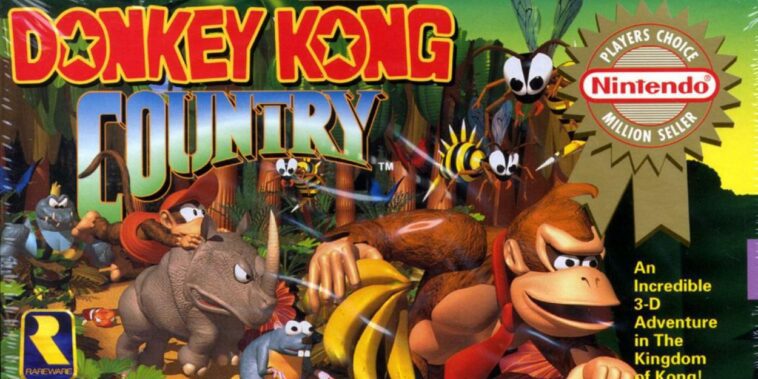PopCulture25YL looks back at the music, shows, comics, books and whatever else we want from the month that was November of 1994 to explore why they’re still relevant to us 25 years later. This week brings us Batman: The Animated Series’ “Batgirl Returns,” the debut of the Spider-Man cartoon, Friends’ “The One When Nana Died Twice,” King’s Quest VII, and Donkey Kong Country.
VHS In The VCR
What a week this was! Not only did we get Scully back in The X-Files (as covered in the soon-to-be-released article on “One Breath”), but the next day aired my all-time favorite episode of Batman: The Animated Series.
Batman: The Animated Series- “Batgirl Returns” by John Bernardy
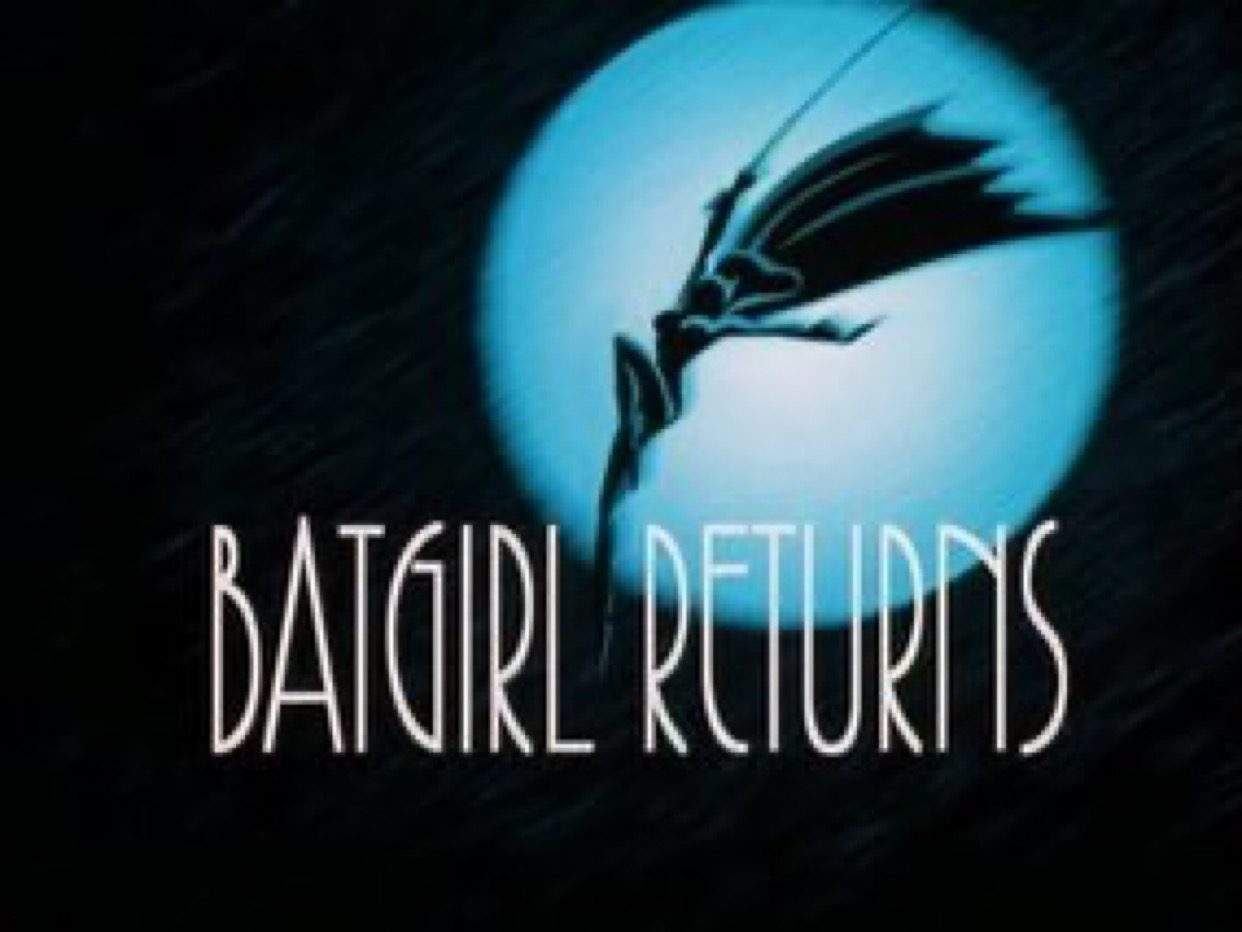
Why is this episode my favorite? First of all, Batgirl is my favorite member of the bat family, probably due to Yvonne Craig imprinting on me at an early age when watching Batman ’66 re-runs on WGN and Nickelodeon. But also, Barbara Gordon is all-around amazing. She wants to impress Batman and her father—Commissioner Gordon—but she also wants to excel for herself. She’s got brains, sass, confidence, and is constantly underestimated. She’s a perfect character to identify with as a kid when you’re honing your skills and just want to be treated as a valid part of the team by the grown-ups in your life.
Batgirl had few appearances in B:TOS, so I savored every appearance I could get. And in this episode she took center stage as she found a rival and mentor in Catwoman. The two teamed up together against crime boss Roland Daggett as they used their detection skills to recover the Jade Cat statue which was recently stolen from the museum.
I’d be remiss if I didn’t talk about the symphonic score that ran intuitively against any other concurrent show—everyone else went with something like “Teenage Mutant Ninja Turtles, heroes in a half-shell, turtle power”; you know the type—and the cartoon’s art deco style that was painted on black background. This show was noir as hell and it was a glorious breath of class in a sea of silliness. The line deliveries here went accordingly. Barbara sounded like she was straight out of a Bogart flick, thanks to actress Melissa Gilbert. She and Adrienne Barbeau (who played Catwoman on the series) made as great a team as their characters did. The real crime of this episode is that they never got to share scenes together again as suggested by the ending.
After that gorgeous title card, the episode began properly with the Jade Cat statue being stolen by someone wearing gray. Then we get the dream sequence where Batman is on the ropes, almost defeated by Penguin, Joker and Two-Face’s simultaneous attack. That is, until Batgirl swings in and takes care of them handily. And that is, until Dick Grayson wakes her up—right before she and Batman were going to kiss. Think maybe that’s a reason she wants to impress the Bat?
Thanks to a WayneCorp merger, that’s as much Batman as we get this episode. The rest of the time involves the case of the missing Jade Cat statue.
Batgirl and Catwoman’s meet-cute happens because they independently investigated the robbery at the same time. And unlike Robin—who regularly pops in and out as he’s also investigating—Batgirl is smart enough to know the robbery wasn’t done in Catwoman’s style. So they call a truce and actually get it done. They really do make a good team, even when they don’t entirely trust each other.
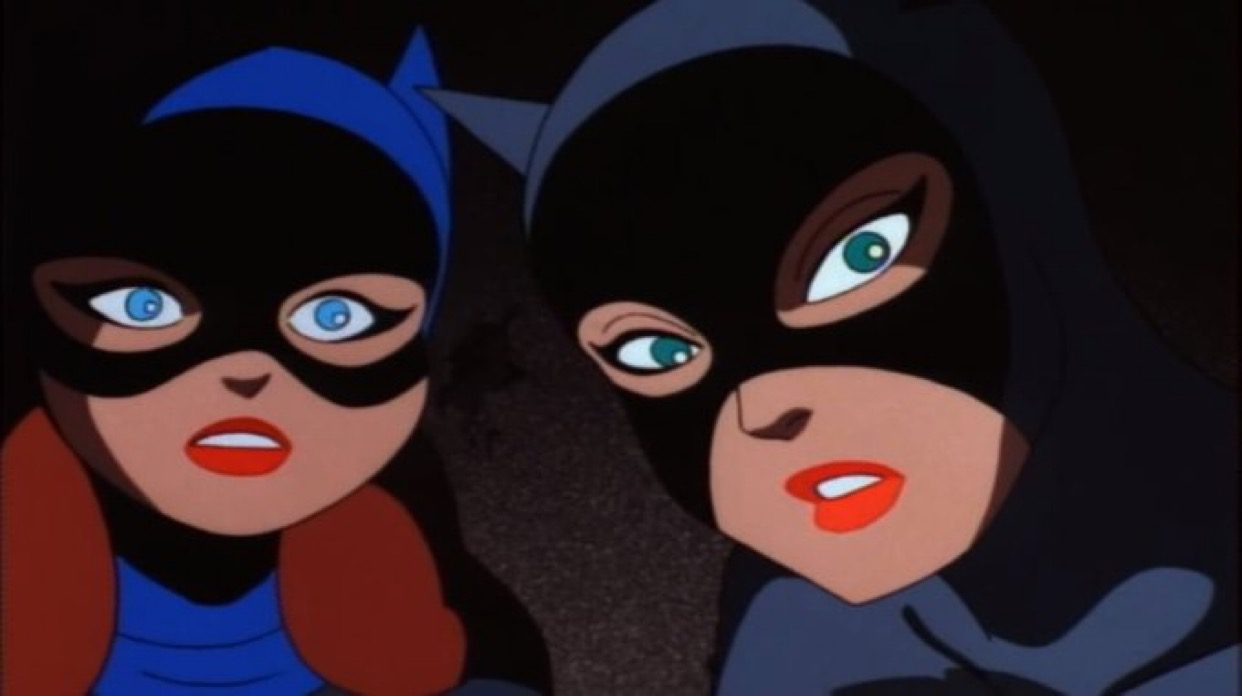
The ladies spar, track down the maker of the acid used in the theft, then get into some trouble with Roland Daggett. And they do eventually get the Jade Cat back. Except of course Catwoman tries to steal it after all, but this time Batgirl catches her outright before Catwoman gets away, acting more like the Batgirl in her dream sequence.
Catwoman even holds up her part of the bargain: she turns herself in because she was less than honest with Babs. Just don’t ask Catwoman how far she’d let the police take her.
At the end of the day, Batgirl gets more respect from—and more respect for—Catwoman and Robin throughout the course of this episode. She’s in a satisfying in-between place that could have made for some stellar stories as she moved from not-quite sidekick into the ranks officially, and as a bonus we got to see Catwoman work with the good guys while still maintaining her individuality. It’s a solid character piece and no one was acting out of character to make this happen. This episode exemplifies what I love most about this classic series.
Someone else must have really loved this episode too, because this was used as a lead-in to the highly-advertised, much-anticipated debut of Spider-Man, covered next by our own Simon McDermott.
Spider-Man by Simon McDermott
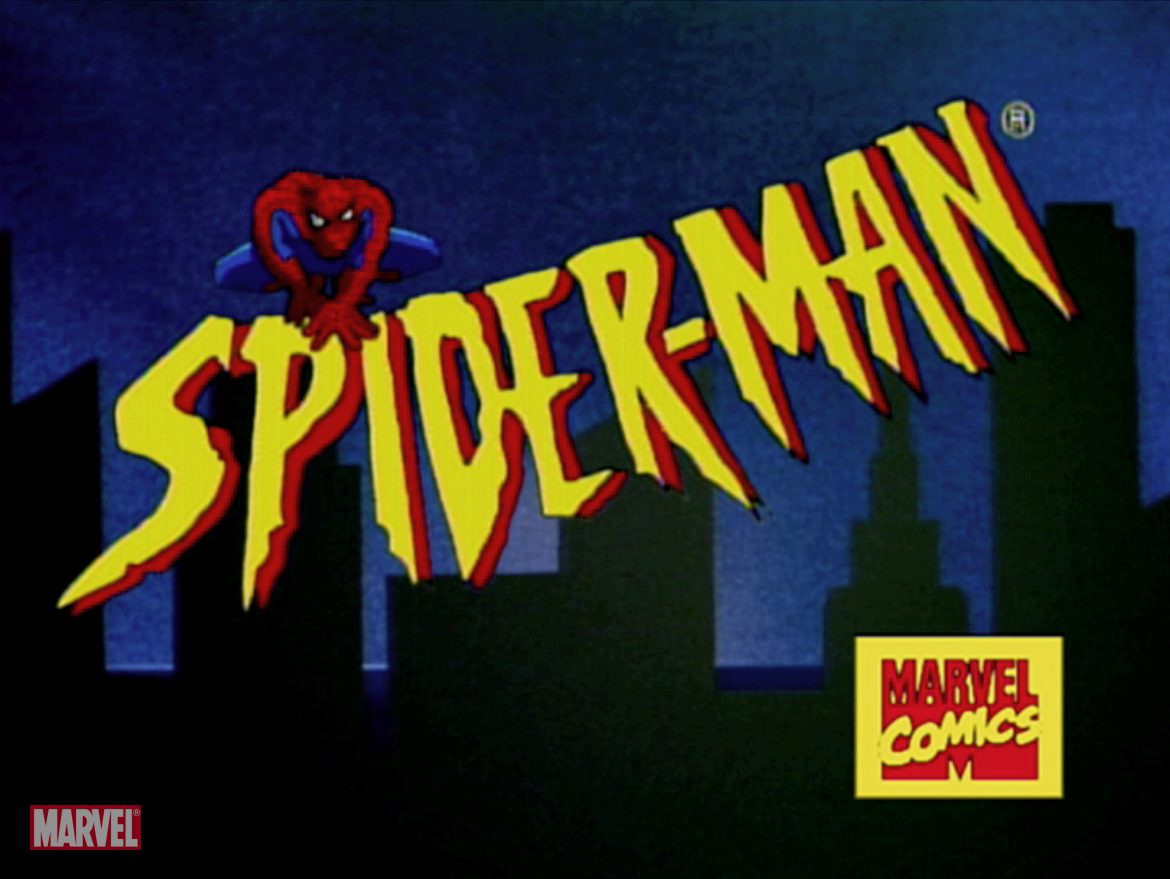
It’s odd how Marvel and DC are distinctly better at certain types of media. DC have always been better at stand-alone, more creative films, whereas Marvel are now famous for perfecting the shared cinematic universe. DC have some incredible animated movies but Marvel have the best cartoons. DC did have Batman: The Animated Series and would later catch up in the ’00s with the excellent Justice League and Teen Titans but in the ‘90s Marvel dominated with their shows for Spider-Man, X-Men, Iron Man, Fantastic Four, Hulk and Silver Surfer. However, Spider-Man was the only one of these that was produced in-house by Marvel Films Animation.
These cartoons were great translations from the comics and were deep dives into their source material. Spider-Man is one of the—if not the—best of this bunch and it did a lot to secure his position as one of the world’s most popular superheroes. As with all the other Marvel cartoons from this period, they each laid the foundations for the movies that all of these properties got in the ’00s. On a side note, Silver Surfer was the only one who didn’t get his own film but was the focus of the Fantastic Four sequel.
What made Spider-Man stand out from all the others was that it also featured other heroes who would go on to have their own movies such as Captain America, Dr. Strange, Blade, Daredevil and The Punisher. They, along with other heroes, appeared multiple times and would be involved
in storylines that spanned many episodes. It was very progressive in this respect with its long and epic sagas. You could even go as far as to say that this Spider-Man cartoon was the first proper shared universe outside of the comics and its influence can be felt all the way up to the present. There’s even an early version of the plot from Into the Spider-Verse in this show’s run.
The animation style is unique and dynamic because it was animated by Tokyo Movie Shinsha with help from a few Korean animation studios; Japanese animation being known for its vibrant style and rich colours which suited the character perfectly. It even played with computer-generated establishing shots of New York City and the suburbs in Queens. A lot of visual research was done using photo archives of the NYC skyline to accurately recreate rooftops and certain buildings such as the Chrysler building, which doubled as the Kingpin’s hideout. The title sequence was suitably bombastic with iconic music written by Shuki Levy and performed by Joe Perry from Aerosmith.
The cartoon was both critically acclaimed and a massive commercial success. It very quickly became the highest-rated and most popular kids TV show in the US; it also went on to win awards for both its animation and writing. It was universally praised for adapting so many stories from the comic books, something that I’m always so bewildered isn’t done more often as it’s a guaranteed recipe for success. It never hesitated to jump right into layered, complex stories and introduce more characters from Spidey’s impressive back catalogue. It even decided to forgo his origin, which nobody would complain about now, having seen it so many times since.
There have been other great Spidey shows since but this one has really stood the test of time. It’s now finding a whole new generation of fans as Disney are showing reruns of it—after acquiring it from Fox—and it’s the best introduction to the character you can get outside the comics. Just as Batman: The Animated Series is for DC, this cartoon should always be the blueprint for any animated project Marvel undertakes.
Friends- “The One Where Nana Dies Twice” by Abbie Sears
“The One Where Nana Dies Twice” was the second episode of Friends to air in November 1994, and in it we get some very touching moments, existential incidents, questions of sexuality and family drama.
We began the episode in the staff room at Chandler’s office —what is it that he does again?—and his coworker tells him she has the perfect person for him. He’s funny, he’s smart… He’s a he?! Apparently, she thought Chandler was gay, and it seems that’s what all the girls think. Back at the apartment, the gang tells him he has a “quality” that seems unexplainable but makes him seem very, very gay.
Last episode, Rachel met Paolo and it seems that fling is still flinging when he calls from Rome. Rachel gets incredibly giddy, oh, he’s calling from Rome! To quote Ross, “So he’s calling from Rome. I could do that, just gotta go to Rome!” That line is hilarious every time.
Monica gets a call from her dad, letting her know her nana is in the hospital and they rush over to see her. Here we are reunited with the Gellers, and it isn’t too long before the nurse announces that Monica and Ross’s grandma has passed away. When they go in to say goodbye, and Ross leans down to hug her, he has quite the opposite of a Prince Charming moment. Nana reaches her arm out and moves and sends everyone into a mass panic. “She’s not passed, she’s present, she’s back!” Ross exclaims, but unfortunately, nana had passed.
At the coffee shop, Phoebe announces that she believes when you’re gone you are still here in spirit. Of course, she has a rather strange story to accompany this thought. Her friend Debbie got struck by lightning on a miniature golf course, and whenever she uses a little yellow pencil, she feels Debbie near her. Rachel hands her a pencil and she comes back with “I don’t know who this is but it’s not Debbie.”
We see quite a lovely moment as Ross organises his grandmas clothes, and he opens a container above him and Sweet ’N Low packets rain down on him. Nana would steal them from anywhere she went and kept them in storage, it was a fond memory for Ross.
The highlight of the episode comes after the funeral when the guys walk through the cemetery and Ross realises his biggest fear when he falls into a grave. Ross may have been slightly hurt, but it was amazing.
Interestingly, at the funeral, we learn that Nana is to Monica’s mother as Monica’s mother is to Monica. She is picky, and critical, and drove Judy insane.
Ross takes quite a few painkillers and ends up telling everyone how much he loves them, as we all do. But he lets Rachel know that he loves her the most. She reciprocates, but in his state he collapses across her lap complaining she “doesn’t get it!”
The episode ends with a humorous coffee house scene, where the gang look through old pictures and find Ross naked. To Joey’s excitement he finds a possible naked Monica, but no, that would be Ross again. He was just, uh… trying something.
Mashing Buttons
King’s Quest VII by Bryan O’Donnell
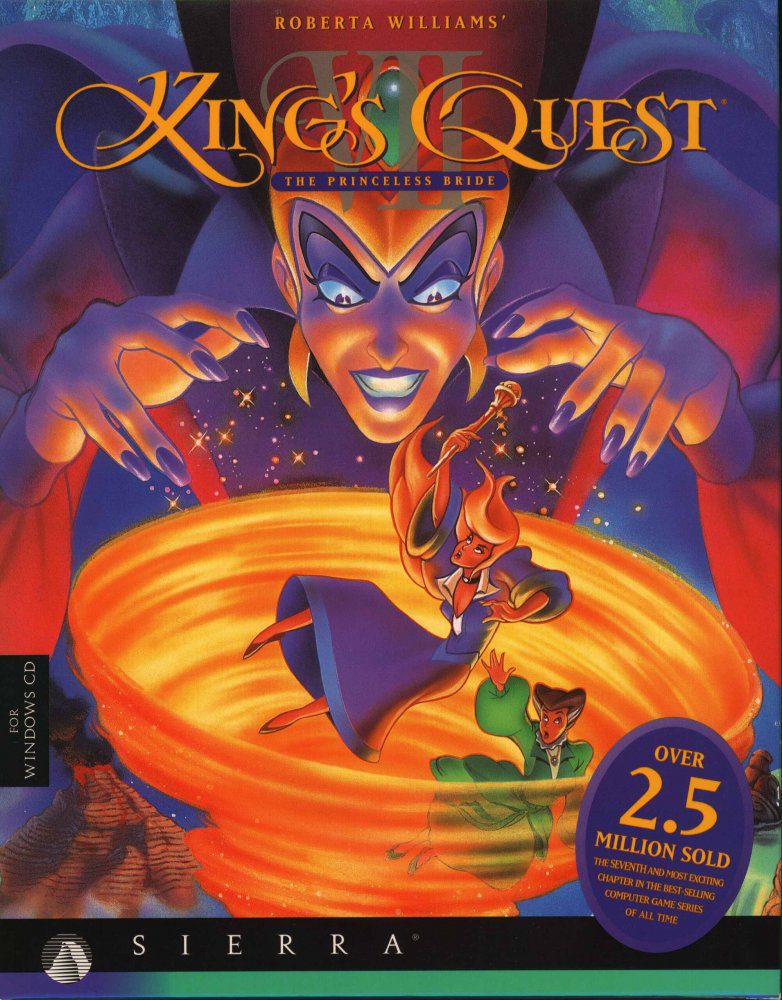
Some of my earliest video game memories revolve around playing the original King’s Quest on the PC. I put in hours of trial and error, as the game required you to type in prompts (e.g., “open door”, “take bowl”, etc.) to move the game along. I remember the moment I realized I need to “show” a carrot to a goat to get him to follow me and the lead him to knocking off a troll from a bridge—as opposed to just “giving” the goat the carrot, in which he’d just eat it and then ignore me. Figuring out that puzzle (without hints from the internet, obviously) was a cause for a massive celebration.
Fast forward a few years and iterations, and King’s Quest VI was blowing my mind with its inventiveness and quirks (and at the time, its graphics). This game captured my imagination and provided so many good video game memories. So when the next game in the series, King’s Quest VII: The Princeless Bride, was released in November 1994, I was psyched. Ultimately, I enjoyed King’s Quest VII, but it differed greatly from the previous games in the series—so much so that it hardly felt like a traditional King’s Quest game.
One obvious difference is the game’s graphics. King’s Quest VII featured an animated look, almost like an animated Disney movie. Overall, the graphics are actually quite excellent but miss a bit of the gritty-fairy-tale feel of previous King’s Quest games.
The gameplay also differed greatly from other games in the series. By KQV, the series had moved on from the typing interface, but KQVII got rid of the traditional “talk, look, take, use” icon interface and instead used a wand as a cursor. When the wand flashed over an item, door, or person, it meant you could interact with it. This simplified things a bit, but didn’t take the fun out of things.
Another difference in KQVII was that you played through the perspective of two characters: Queen Valanice and Princess Rosella. The game is divided into chapters (another difference) and when a chapter was completed, the story would switch over to the other character until finally meeting up in the end. The plot involves the queen and princess being transported to another world (and separated), interacting with a number of interesting characters and locations. KQVII didn’t have the same impact for me as some of the previous games, but it was still memorable.
Unfortunately, it was a bit of an end of the series for me. An eighth game (King’s Quest: Mask of Eternity) was released in 1998, but I never tried it out. And an episodic game for the Playstation and Xbox consoles came out in 2015, and likewise, I haven’t had the interest to give it a download. My feelings for King’s Quest these days live in the past. Nothing will likely be able to replicate the magical vibe of those early King’s Quest adventures.
Donkey Kong Country by Conor O’Donnell
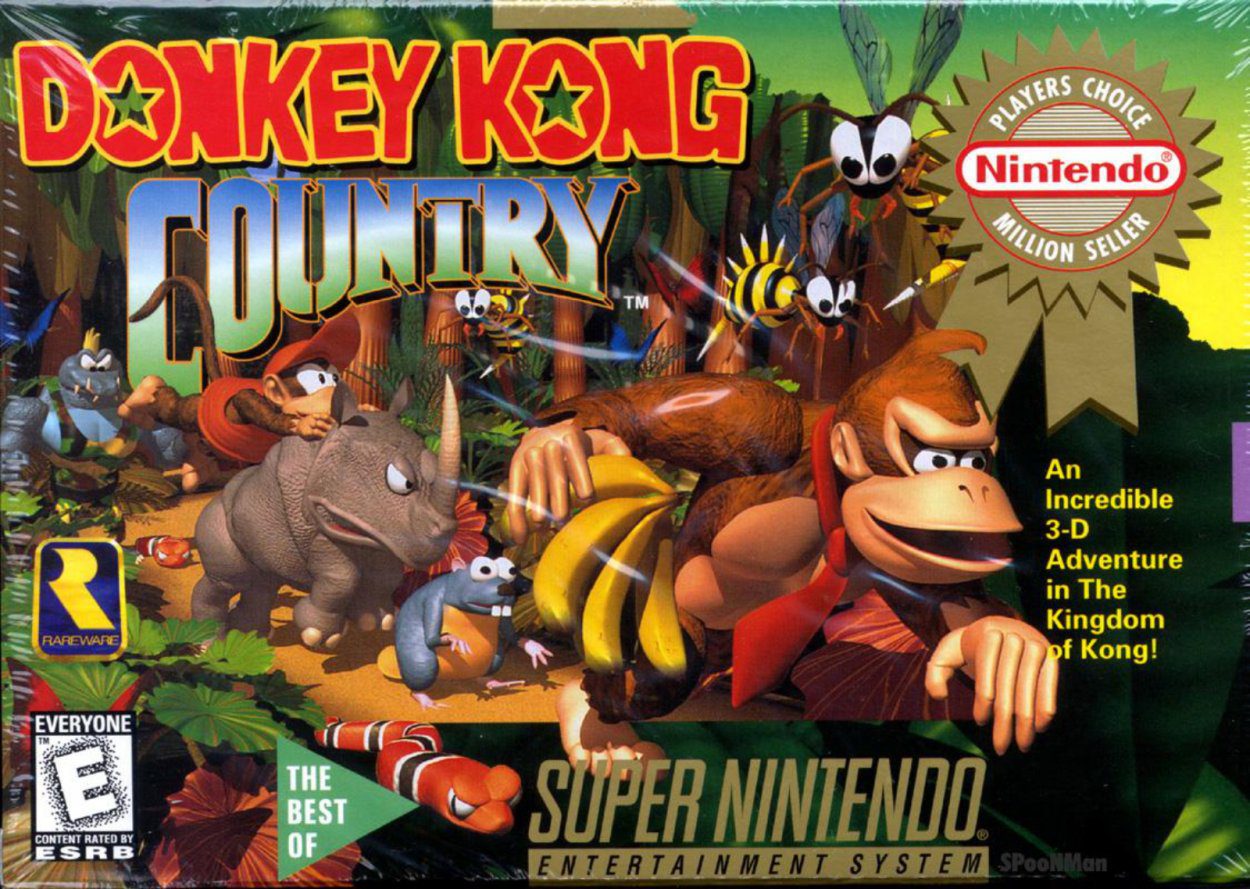
“Mortal Kombat on the Sega Genesis is the best video game ever.”
“I disagree, it’s a very good game but I think Donkey Kong is the best game ever.”
A few random quotes from Billy Madison that highlight how I felt back in 1994. The lunch table argument in the console wars was over. Nintendo was firing on all cylinders in 1994 with titles like Super Metroid, Final Fantasy VI, and now Donkey Kong Country. I think we’re done here. I preferred the Super Nintendo over the Genesis mainly because of the plethora of quality RPGs. Donkey Kong Country however was a simple platformer that blew me away and still amazes me today.
Games like NBA Jam and Mortal Kombat II, which were both awesome games on both consoles, were becoming less popular at friend gatherings. Donkey Kong Country was an exclusive title that felt universally loved. The graphics felt like Nintendo reached the peak to what the Super Nintendo could do. Sega fans couldn’t pull the ‘Blast Processing’ card anymore. Donkey Kong, unlike the majority of other Nintendo IPs, had been reinvented from an old school arcade game into a monstrously successful platform franchise. It would spawn two sequels. All three games would crack the top 10 bestselling Super Nintendo games of all time.
What makes Donkey Kong Country so great? Besides the graphics, this game is most renowned for its soundtrack. Frequently while working, I have fired up “Aquatic Ambiance” from the underwater levels on repeat. Unlike Mortal Kombat, there’s no worry of blood or disembowelment in Donkey Kong. Nintendo has consistently made sure their games reach the widest audience possible. It was tradition for my cousins and my brother to beat the game every Christmas. There was never a disagreement to pop this gem in.
Donkey Kong Country also introduced a new cast of characters that would become Nintendo staples. Donkey Kong teamed up with his nephew Diddy Kong who was smaller but faster. Each character had their advantages taking down certain enemies. Each environment had a boss fight. The difficulty ramped up just right. The hidden secrets were a pleasure to seek out. It’s hard to think of downsides with this game quite frankly.
The Donkey Kong franchise would never quite reach the overwhelming fan and critical claim to the Super Nintendo installments. My family hasn’t played Donkey Kong Country at Christmas for a while now. Luckily this game was included in the Super Nintendo Classic which will hopefully revive the tradition soon.

